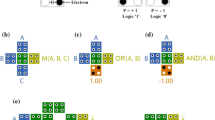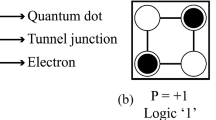Abstract
Signed-digit adder, which eliminates carry propagation chain, can execute addition operation independent of the length of operands, in constant time. The confined carry propagation implies remarkable advantage in terms of error detection, localization, and correction. We developed a new low-cost technique, for fault-localization and error-correction, which utilizes the self-dual concept in binary signed-digit adders. The foundational idea of our technique is that the designed method, when fed by the complement of its functional input under the existence of a stuck-at fault, yields a fault-free inverse of the expected output. In this method, after detection of a fault, the method continues with input inversion, recomputation, and desired output inversion. The faulty component will localize by comparison of the faulty and fault-free outputs. Higher reliability with less computational time and reduced hardware-area overhead are the distinct features of this new design. In this method, all of the single stuck-at faults can be localized and corrected, whereas previous approaches were unable to localize and correct with 100 % reliability even with longer time durations and greater hardware cost. The experimental results prove that our design requires 20 %–90 % less time and 20 %–40 % smaller area overhead compared with a previous related work.






Similar content being viewed by others
References
Mukherjee, S. (2011). Architecture design for soft errors. Morgan Kaufmann.
Mehdizadeh, N., Shokrolah-Shirazi, M., & Miremadi, S. G. (2008). Analyzing fault effects in the 32-bit OpenRISC 1200 microprocessor. In Availability, IEEE Third International Conference on Reliability and Security. (pp. 648–652)
Meixner, A., Bauer, M. E., & Sorin, D. J. (2007). Argus: Low-cost, comprehensive error detection in simple cores. In 40th Annual IEEE/ACM International Symposium on Microarchitecture, MICRO 2007. (pp. 210–222)
Pellegrini, A., Smolinski, R., Chen, L., Fu, X., Hari, S. K. S., Jiang, J., ... & Bertacco, V. (2012). CrashTest’ing SWAT: accurate, gate-level evaluation of symptom-based resiliency solutions. In Proceedings of the conference on design, automation and test in Europe (pp. 1106–1109). EDA Consortium
Hong, S., & Kim, S. (2010). Lizard: Energy-efficient hard fault detection, diagnosis and isolation in the ALU. In IEEE International Conference on Computer Design (ICCD), (pp. 342–349)
Koren, I., & Krishna, C. M. (2010). Fault-tolerant systems. Morgan Kaufmann
Lyons, R. E., & Vanderkulk, W. (1962). The use of triple-modular redundancy to improve computer reliability. IBM Journal of Research and Development, 6(2), 200–209.
Nicolaidis, M. (2003). Carry checking/parity prediction adders and ALUs. IEEE Transactions on Very Large Scale Integration (VLSI) Systems, 11(1), 121–128.
Lee, C. Y., Chiou, C. W., & Lin, J. M. (2010). Concurrent Error Detection in Multiplexer-Based Multipliers for Normal Basis of GF (2 m) Using Double Parity Prediction Scheme. Journal of Signal Processing Systems, 58(2), 233–246
FUJIWARA, E., & HARUTA, K. (1981). Fault-tolerant arithmetic logic unit using parity-based codes. IEICE TRANSACTIONS (1976–1990), 64(10), 653–660.
Nicolaidis, M. (1993). Efficient implementations of self-checking adders and ALUs. In The Twenty-Third International Symposium on Fault-Tolerant Computing, 1993. FTCS-23. Digest of Papers., (pp. 586–595). (June)
Oikonomakos, P., & Fox, P. (2006). Error correction in arithmetic operations by I/O inversion. In 12th IEEE International Symposium on On-Line Testing. IOLTS (pp. 6-pp)
Valinataj, M., Safari, S. (2007). Fault Tolerant Arithmetic Operations With Multiple Error Detection and Correction. 22th IEEE International Symposium on Defect and Fault Tolerance in VLSI Systems (DFT07), pp. 188–196
Valinataj, M. (2014). A novel self-checking carry lookahead adder with multiple error detection/correction. Microprocessors and Microsystems, 38(8), 1072–1081.
Valinataj, M. (2015). Fault-tolerant carry look-ahead adder architectures robust to multiple simultaneous errors. Microelectronics Reliability Volume 55, Issue 12, Part B, pp 2845–2857
Cardarilli, G. C., Ottavi, M., Pontarelli, S., Re, M., & Salsano, A. (2003). Error detection in signed digit arithmetic circuit with parity checker. In Proceedings 18th IEEE International Symposium on Defect and Fault Tolerance in VLSI Systems. (pp. 401–408
Cardarilli, G. C., Ottavi, M., Pontarelli, S., Re, M., & Salsano, A. (2006). Fault localization, error correction, and graceful degradation in radix 2 signed digit-based adders. IEEE Transactions on Computers, 55(5), 534–540.
Moradian, H., & Lee, J. A. (2015). Low-Cost Fault Localization and Error Correction for a Signed Digit Adder Design Utilizing the Self-Dual Concept. In Euromicro Conference on Digital System Design (DSD) (pp. 276–279)
Avizienis, A. (1961). Signed-digit number representations for fast parallel arithmetic. IRE Transactions on Electronic Computers (3), 389–400.
Ercegovac, M. D., & Lang, T. (2013). Digital arithmetic, Morgan Kaufmann.
Parhami, B. (1988). Carry-free addition of recoded binary signed-digit numbers. IEEE Transactions on Computers, 37(11), 1470–1476.
Alavi, S. R., & Faez, K. (2007). Fault Localization and Full Error Correction in Radix2 Signed Digit-Based Adders. In IEEE Pacific Rim Conference on Communications, Computers and Signal Processing, PacRim. (pp. 214–218) (August)
Ngai, T., He, C., & Swartzlander, E. E. (2001). Enhanced concurrent error correcting arithmetic unit design using alternating logic. In Proceedings of the IEEE International Symposium on Defect and Fault Tolerance in VLSI Systems. (pp. 78–83).
Patel, J. H., & Fung, L. Y. (1982). Concurrent error detection in ALU’s by recomputing with shifted operands. IEEE Transactions on Computers, 100(7), 589–595.
Acknowledgments
This research was supported by National Research Foundation of Korea funded by the Ministry of Science, ICT and Future Planning (NRF-2013R1A1A3012335 and NRF-2016R1A2B4010382). This work was also supported by the Korea Institute of Energy Technology Evaluation and Planning (KETEP) and the Ministry of Trade, Industry & Energy (MOTIE) of the Republic of Korea (No. 20164010201020).
Author information
Authors and Affiliations
Corresponding author
Rights and permissions
About this article
Cite this article
Moradian, H., Lee, JA. & Yu, J. Efficient Low-Cost Fault-Localization and Self-Repairing Radix-2 Signed-Digit Adders Applying the Self-Dual Concept. J Sign Process Syst 88, 297–309 (2017). https://doi.org/10.1007/s11265-016-1162-1
Received:
Revised:
Accepted:
Published:
Issue Date:
DOI: https://doi.org/10.1007/s11265-016-1162-1




